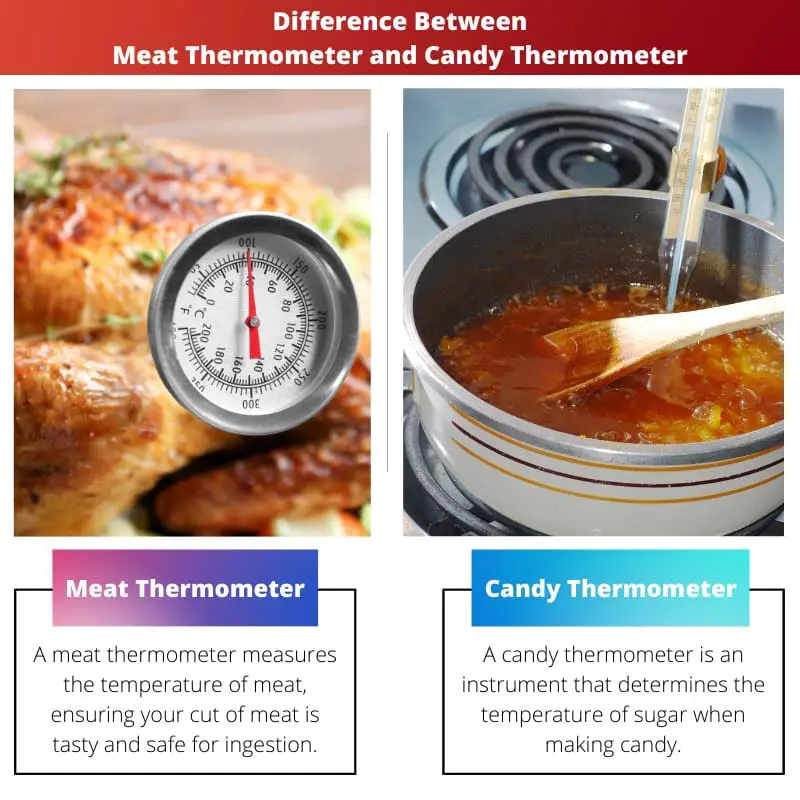Food is all about finding the right balance, which you can achieve by cooking at the right temperature. You can use a kitchen thermometer to measure for this purpose.
But remember, not all kitchen thermometers are the same. So, if you cook often, it is best to keep both types of thermometers, meat and candy, handy.
Key Takeaways
- A meat thermometer is designed to measure the internal temperature of meat, while a candy thermometer is used to measure the temperature of sugar syrup.
- Meat thermometers are equipped with a probe that can be inserted into the meat, while candy thermometers are equipped with a clip that attaches to the side of the pan.
- Meat thermometers are designed to measure a range of temperatures, while candy thermometers are calibrated to measure specific temperatures for candy-making.
Meat Thermometer vs Candy Thermometer
A meat thermometer is a useful device for cooking that measures the temperature of meat. It can measure a short range of temperatures up to 200 degrees Fahrenheit to check if the meat is cooked safely for consumption. A candy thermometer is a device used to measure the temperature of sugar in candy making. It is a long thermometer that can work up to high temperatures up to 400 degrees Fahrenheit.

Getting the temperature right when cooking meat is essential, especially when you are working with sizeable portions. Using a meat thermometer, you can determine this value, ensuring it falls in the safe range.
That prevents your choice of protein from being too rare, bordering on raw or too cooked, becoming chewy.
Making candy at home can be difficult because its main ingredient, sugar, is highly heat-sensitive. So, you need to control the temperature at which you cook your sugar.
For this, you need a candy thermometer. That will make sure you get your candy right on the first try.
Comparison Table
| Parameter of Comparison | Meat Thermometer | Candy Thermometer |
|---|---|---|
| Definition | A meat thermometer measures the temperature of meat, ensuring your cut of meat is tasty and safe for ingestion. | A candy thermometer is an instrument that determines the temperature of sugar when making candy. |
| Usage | A meat thermometer is used to determine the temperatures of various cuts of meat, including chicken, fish, etc. | A candy thermometer is primarily used to monitor the temperature of sugar while preparing candy, sweet sauces, syrups, and fried foods. |
| Structure | A meat thermometer is a short tool. It has a pointed end that pokes into the meat and a dial. | A candy thermometer is long and narrow, making it easy to dip into the hot sugar. |
| Temperature range | A meat thermometer can measure a short range of temperatures, going up to 200°F. | A candy thermometer can work at high temperatures, going up to around 400°F. |
What is A Meat Thermometer?
When you prepare your meat based on an estimated cooking time, it can be hard to get it right. Sometimes, it remains far too undercooked, bordering on raw and unsafe for ingestion.
Other times, it gets too overcooked, becoming chewy and tasteless. Hitting that perfect spot is only possible through a precise parameter, which is temperature.
A meat thermometer is a kitchen instrument that helps you measure how hot a piece of meat is. It is short, but it has a sharp end. You can poke this through the food to determine its internal temperature.
A typical meat thermometer can measure a maximum temperature of 200°F. It shows this value through the digital or analogue dial present on its other end.
Attaining that perfect cooking temperature ensures the meat is not only safe for consumption but also tasty.
Although it is most useful for large slabs of meat, you can use a meat thermometer to find the temperature of any piece. Fish, chicken, beef, turkey, etc., turn out delicious when cooked at the correct heat.
A standard meat thermometer lasts for quite a while if you handle it carefully. But you might have to calibrate it from time to time. That will make sure you get an accurate reading every time you use it.
What is A Candy Thermometer?
Sugar is not simple to work with since it can burn in the blink of an eye. But if it does not get enough heat, it also cannot turn into candy. Measuring its temperature solves this issue since you have more control over how hot it gets.
Monitoring the temperature of your candy mix, which contains sugar, is thus crucial. You can get both hard and soft candy in different textures or consistencies simply by varying the heat.
Hence, to check the temperature of the sugar, you have to use a candy thermometer. It is also helpful when you are frying foods to get the perfect mix of crispy and chewy.
A candy thermometer is a device that can determine how hot a candy mixture, sweet sauce or syrup is. It resembles a long, thin stick that you can dip into the pot without burning yourself.
You can also attach it to the side of the container to take better and safer readings. It can measure much higher temperatures compared to meat thermometers, maxing out at 400°F.

Main Differences Between A Meat Thermometer and A Candy Thermometer
- A meat thermometer is used to find the temperature of the meat, while a candy thermometer reads the temperature of sugar, candy, and other sweet treats.
- A meat thermometer is short, while a candy thermometer is long and narrow.
- You can pierce a meat thermometer directly through the meat and take a close look. When using a candy thermometer, you have to dip it in and take the reading from afar to be safe.
- Meat thermometers are not attachable to the pot or pan, while candy thermometers are.
- Meat thermometers can measure temperatures up to 200°F. This value goes up to 400°F for candy thermometers.

- https://pubs.acs.org/doi/abs/10.1021/acs.jchemed.7b00739
- https://www.sciencedirect.com/science/article/abs/pii/S0956713519302737

An essential guide that emphasizes the crucial role of meat and candy thermometers in the culinary world. This post is a valuable resource for all cooking enthusiasts.
Very insightful post. We overlook the importance of maintaining the right temperature while cooking. Both meat and candy thermometers are essential tools in the kitchen to ensure the perfect balance in cooking.
Although an interesting read, I was expecting an in-depth analysis of the scientific principles behind the meat and candy thermometers. It would’ve added more value to the post.
Great article on the importance of finding the right temperature for cooking! Very informative and useful for people who cook often. A must-read for any aspiring chefs!
The post effectively highlights the importance of using precise temperature measurements for cooking. A well-written comparison between meat and candy thermometers. Kudos to the author!
An engaging read that provides useful insights into the importance of finding the right temperature while cooking with meat and candy thermometers. A truly enlightening piece!
An intriguing article that provides a detailed comparison of meat and candy thermometers and the significance of maintaining the right temperature while cooking. A commendable piece of work!
This article was not only informative but also an important guide to help us understand the significance of using meat and candy thermometers while cooking. An excellent piece for cooking enthusiasts.